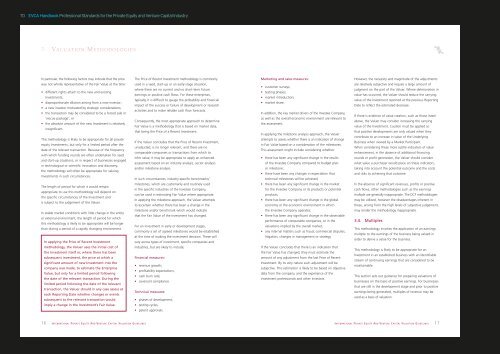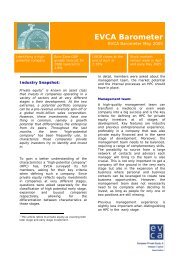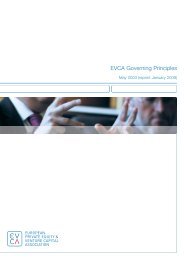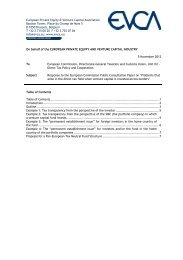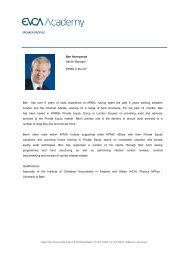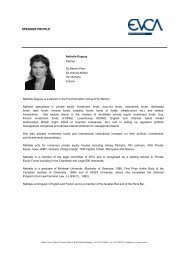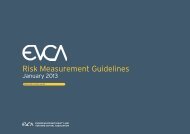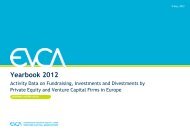70 <strong>EVCA</strong> <strong>H<strong>and</strong>book</strong> <strong>Professional</strong> <strong>St<strong>and</strong>ards</strong> <strong>for</strong> <strong>the</strong> <strong>Private</strong> <strong>Equity</strong> <strong>and</strong> Venture Capital Industry3. VALUATION M ETHODOLOGIESIn particular, <strong>the</strong> following factors may indicate that <strong>the</strong> pricewas not wholly representative of <strong>the</strong> Fair Value at <strong>the</strong> time:• different rights attach to <strong>the</strong> new <strong>and</strong> existingInvestments;• disproportionate dilution arising from a new investor;• a new investor motivated by strategic considerations;• <strong>the</strong> transaction may be considered to be a <strong>for</strong>ced sale or‘rescue package’; or• <strong>the</strong> absolute amount of <strong>the</strong> new Investment is relativelyinsignificant.This methodology is likely to be appropriate <strong>for</strong> all privateequity Investments, but only <strong>for</strong> a limited period after <strong>the</strong>date of <strong>the</strong> relevant transaction. Because of <strong>the</strong> frequencywith which funding rounds are often undertaken <strong>for</strong> seed<strong>and</strong> start-up situations, or in respect of businesses engagedin technological or scientific innovation <strong>and</strong> discovery,<strong>the</strong> methodology will often be appropriate <strong>for</strong> valuingInvestments in such circumstances.The length of period <strong>for</strong> which it would remainappropriate to use this methodology will depend on<strong>the</strong> specific circumstances of <strong>the</strong> Investment <strong>and</strong>is subject to <strong>the</strong> judgement of <strong>the</strong> Valuer.In stable market conditions with little change in <strong>the</strong> entityor external environment, <strong>the</strong> length of period <strong>for</strong> whichthis methodology is likely to be appropriate will be longerthan during a period of a rapidly changing environment.In applying <strong>the</strong> Price of Recent Investmentmethodology, <strong>the</strong> Valuer uses <strong>the</strong> initial cost of<strong>the</strong> Investment itself or, where <strong>the</strong>re has beensubsequent investment, <strong>the</strong> price at which asignificant amount of new Investment into <strong>the</strong>company was made, to estimate <strong>the</strong> EnterpriseValue, but only <strong>for</strong> a limited period following<strong>the</strong> date of <strong>the</strong> relevant transaction. During <strong>the</strong>limited period following <strong>the</strong> date of <strong>the</strong> relevanttransaction, <strong>the</strong> Valuer should in any case assess ateach Reporting Date whe<strong>the</strong>r changes or eventssubsequent to <strong>the</strong> relevant transaction wouldimply a change in <strong>the</strong> Investment’s Fair Value.The Price of Recent Investment methodology is commonlyused in a seed, start-up or an early-stage situation,where <strong>the</strong>re are no current <strong>and</strong> no short-term futureearnings or positive cash flows. For <strong>the</strong>se enterprises,typically, it is difficult to gauge <strong>the</strong> probability <strong>and</strong> financialimpact of <strong>the</strong> success or failure of development or researchactivities <strong>and</strong> to make reliable cash flow <strong>for</strong>ecasts.Consequently, <strong>the</strong> most appropriate approach to determineFair Value is a methodology that is based on market data,that being <strong>the</strong> Price of a Recent Investment.If <strong>the</strong> Valuer concludes that <strong>the</strong> Price of Recent Investment,unadjusted, is no longer relevant, <strong>and</strong> <strong>the</strong>re are nocomparable companies or transactions from which toinfer value, it may be appropriate to apply an enhancedassessment based on an industry analysis, sector analysis<strong>and</strong>/or milestone analysis.In such circumstances, industry-specific benchmarks/milestones, which are customarily <strong>and</strong> routinely usedin <strong>the</strong> specific industries of <strong>the</strong> Investee Company,can be used in estimating Fair Value where appropriate.In applying <strong>the</strong> milestone approach, <strong>the</strong> Valuer attemptsto ascertain whe<strong>the</strong>r <strong>the</strong>re has been a change in <strong>the</strong>milestone <strong>and</strong>/or benchmark which would indicatethat <strong>the</strong> Fair Value of <strong>the</strong> investment has changed.For an investment in early or development stages,commonly a set of agreed milestones would be establishedat <strong>the</strong> time of making <strong>the</strong> investment decision. These willvary across types of investment, specific companies <strong>and</strong>industries, but are likely to include;Financial measures:• revenue growth;• profitability expectations;• cash burn rate;• covenant compliance.Technical measures:• phases of development;• testing cycles;• patent approvals.Marketing <strong>and</strong> sales measures:• customer surveys;• testing phases;• market introduction;• market share.In addition, <strong>the</strong> key market drivers of <strong>the</strong> Investee Company,as well as <strong>the</strong> overall economic environment are relevant to<strong>the</strong> assessment.In applying <strong>the</strong> milestone analysis approach, <strong>the</strong> Valuerattempts to assess whe<strong>the</strong>r <strong>the</strong>re is an indication of changein Fair Value based on a consideration of <strong>the</strong> milestones.This assessment might include considering whe<strong>the</strong>r:• <strong>the</strong>re has been any significant change in <strong>the</strong> resultsof <strong>the</strong> Investee Company compared to budget planor milestone;• <strong>the</strong>re have been any changes in expectation thattechnical milestones will be achieved;• <strong>the</strong>re has been any significant change in <strong>the</strong> market<strong>for</strong> <strong>the</strong> Investee Company or its products or potentialproducts;• <strong>the</strong>re has been any significant change in <strong>the</strong> globaleconomy or <strong>the</strong> economic environment in which<strong>the</strong> Investee Company operates;• <strong>the</strong>re has been any significant change in <strong>the</strong> observableper<strong>for</strong>mance of comparable companies, or in <strong>the</strong>valuations implied by <strong>the</strong> overall market;• any internal matters such as fraud, commercial disputes,litigation, changes in management or strategyIf <strong>the</strong> Valuer concludes that <strong>the</strong>re is an indication that<strong>the</strong> Fair Value has changed, <strong>the</strong>y must estimate <strong>the</strong>amount of any adjustment from <strong>the</strong> last Price of RecentInvestment. By its very nature such adjustment will besubjective. This estimation is likely to be based on objectivedata from <strong>the</strong> company, <strong>and</strong> <strong>the</strong> experience of <strong>the</strong>investment professionals <strong>and</strong> o<strong>the</strong>r investors.However, <strong>the</strong> necessity <strong>and</strong> magnitude of <strong>the</strong> adjustmentsare relatively subjective <strong>and</strong> require a large amount ofjudgment on <strong>the</strong> part of <strong>the</strong> Valuer. Where deterioration invalue has occurred, <strong>the</strong> Valuer should reduce <strong>the</strong> carryingvalue of <strong>the</strong> Investment reported at <strong>the</strong> previous ReportingDate to reflect <strong>the</strong> estimated decrease.If <strong>the</strong>re is evidence of value creation, such as those listedabove, <strong>the</strong> Valuer may consider increasing <strong>the</strong> carryingvalue of <strong>the</strong> Investment. Caution must be applied sothat positive developments are only valued when <strong>the</strong>ycontribute to an increase in value of <strong>the</strong> UnderlyingBusiness when viewed by a Market Participant.When considering <strong>the</strong>se more subtle indicators of valueenhancement, in <strong>the</strong> absence of additional financingrounds or profit generation, <strong>the</strong> Valuer should considerwhat value a purchaser would place on <strong>the</strong>se indicators,taking into account <strong>the</strong> potential outcome <strong>and</strong> <strong>the</strong> costs<strong>and</strong> risks to achieving that outcome.In <strong>the</strong> absence of significant revenues, profits or positivecash flows, o<strong>the</strong>r methodologies such as <strong>the</strong> earningsmultiple are generally inappropriate. The DCF methodologiesmay be utilised, however <strong>the</strong> disadvantages inherent in<strong>the</strong>se, arising from <strong>the</strong> high levels of subjective judgement,may render <strong>the</strong> methodology inappropriate.3.4. MultiplesThis methodology involves <strong>the</strong> application of an earningsmultiple to <strong>the</strong> earnings of <strong>the</strong> business being valued inorder to derive a value <strong>for</strong> <strong>the</strong> business.This methodology is likely to be appropriate <strong>for</strong> anInvestment in an established business with an identifiablestream of continuing earnings that are considered to bemaintainable.This section sets out guidance <strong>for</strong> preparing valuations ofbusinesses on <strong>the</strong> basis of positive earnings. For businessesthat are still in <strong>the</strong> development stage <strong>and</strong> prior to positiveearnings being generated, multiples of revenue may beused as a basis of valuation.16 I NTERNATIONAL P RIVATE E QUITY A ND V ENTURE C APITAL VALUATION G UIDELINESI NTERNATIONAL P RIVATE E QUITY A ND V ENTURE C APITAL VALUATION G UIDELINES 17
71 <strong>EVCA</strong> <strong>H<strong>and</strong>book</strong> <strong>Professional</strong> <strong>St<strong>and</strong>ards</strong> <strong>for</strong> <strong>the</strong> <strong>Private</strong> <strong>Equity</strong> <strong>and</strong> Venture Capital Industry3. VALUATION M ETHODOLOGIESA revenue multiple is commonly <strong>the</strong> product of anassumption as to <strong>the</strong> ‘normalised’ level of earnings thatcan be generated from that revenue. The methodology<strong>and</strong> considerations set out here <strong>for</strong> earnings multiplesequally apply if a multiple of revenue is utilised.This methodology may be applicable to companies withnegative earnings, if <strong>the</strong> losses are considered to betemporary <strong>and</strong> one can identify a level of ‘normalised’maintainable earnings.This may involve <strong>the</strong> use of adjusted historic earnings,using a <strong>for</strong>ecast level of earnings or applying a ‘sustainable’profit margin to current or <strong>for</strong>ecast revenues.The most appropriate earnings to use in this methodologywould be those likely to be used by a prospectivepurchaser of <strong>the</strong> business.In using <strong>the</strong> Earnings Multiple methodologyto estimate <strong>the</strong> Fair Value of an Investment,<strong>the</strong> Valuer should:(i) Apply a multiple that is appropriate <strong>and</strong>reasonable (given <strong>the</strong> risk profile <strong>and</strong> earningsgrowth prospects of <strong>the</strong> underlying company)to <strong>the</strong> maintainable earnings of <strong>the</strong> company;(ii) Adjust <strong>the</strong> Enterprise Value <strong>for</strong> surplus assetsor excess liabilities <strong>and</strong> o<strong>the</strong>r contingencies<strong>and</strong> relevant factors to derive an AdjustedEnterprise Value <strong>for</strong> <strong>the</strong> Investee Company;(iii) Deduct from this amount any financialinstruments ranking ahead of <strong>the</strong> highestranking instrument of <strong>the</strong> Fund in aliquidation scenario (e.g. <strong>the</strong> amount thatwould be paid) <strong>and</strong> taking into account <strong>the</strong>effect of any instrument that may dilute <strong>the</strong>Fund’s Investment to derive <strong>the</strong> AttributableEnterprise Value;(iv) Apportion <strong>the</strong> Attributable Enterprise Valueappropriately between <strong>the</strong> relevant financialinstruments.Guidance on <strong>the</strong> interpretation of <strong>the</strong> terms in boldis given below.Appropriate multipleA number of earnings multiples are used, including price/earnings (P/E), Enterprise Value/earnings be<strong>for</strong>e interest<strong>and</strong> tax (EV/EBIT) <strong>and</strong> depreciation <strong>and</strong> amortisation(EV/EBITDA). The particular multiple used should beappropriate <strong>for</strong> <strong>the</strong> business being valued. (N.B: The multiplesof revenues <strong>and</strong> <strong>the</strong>ir use are presented in 3.8. IndustryValuation Benchmarks).In general, because of <strong>the</strong> role of financial structuringin private equity, multiples should be used to derive anEnterprise Value <strong>for</strong> <strong>the</strong> Underlying Business. Where EBITDAmultiples are available, <strong>the</strong>se are commonly used.When unavailable, P/E multiples may be used since <strong>the</strong>seare more commonly reported. For a P/E multiple to becomparable, <strong>the</strong> two entities should have similar financingstructures <strong>and</strong> levels of borrowing.There<strong>for</strong>e, where a P/E multiple is used, it should generallybe applied to an EBIT figure which is adjusted <strong>for</strong> financecosts relating to operations, working capital <strong>and</strong> tax.These adjustments are designed to eliminate <strong>the</strong> effect on<strong>the</strong> earnings of <strong>the</strong> acquisition finance on <strong>the</strong> EnterpriseValue since this is subsequently adjusted.By definition, earnings multiples have as <strong>the</strong>ir numeratora value <strong>and</strong> as <strong>the</strong>ir denominator an earnings figure.The denominator can be <strong>the</strong> earnings figure <strong>for</strong> any specifiedperiod of time <strong>and</strong> multiples are often defined as ‘historical’,‘current’ or ‘<strong>for</strong>ecast’ to indicate <strong>the</strong> earnings used. It isimportant that <strong>the</strong> multiple used correlates to <strong>the</strong> period<strong>and</strong> concept of earnings of <strong>the</strong> company being valued.Reasonable multipleThe Valuer would usually derive a multiple by reference tocurrent market-based multiples, reflected in <strong>the</strong> marketvaluations of quoted companies or <strong>the</strong> price at whichcompanies have changed ownership. This market-basedapproach presumes that <strong>the</strong> comparator companies arecorrectly valued by <strong>the</strong> market.Whilst <strong>the</strong>re is an argument that <strong>the</strong> market capitalisationof a quoted company reflects not <strong>the</strong> value of <strong>the</strong> companybut merely <strong>the</strong> price at which ‘small parcels’ of shares areexchanged, <strong>the</strong> presumption in <strong>the</strong>se Guidelines is thatmarket based multiples are indicative of <strong>the</strong> value of<strong>the</strong> company as a whole.Where market-based multiples are used, <strong>the</strong> aim isto identify companies that are similar, in terms of riskattributes <strong>and</strong> earnings growth prospects, to <strong>the</strong> companybeing valued. This is more likely to be <strong>the</strong> case where<strong>the</strong> companies are similar in terms of business activities,markets served, size, geography <strong>and</strong> applicable tax rate.In using P/E multiples, <strong>the</strong> Valuer should note that<strong>the</strong> P/E ratios of comparator companies will be affectedby <strong>the</strong> level of financial gearing <strong>and</strong> applicable tax rateof those companies.In using EV/EBITDA multiples, <strong>the</strong> Valuer should notethat such multiples, by definition, remove <strong>the</strong> impact onvalue of depreciation of fixed assets <strong>and</strong> amortisation ofgoodwill <strong>and</strong> o<strong>the</strong>r intangibles. If such multiples are usedwithout sufficient care, <strong>the</strong> Valuer may fail to recognisethat business decisions to spend heavily on fixed assets orto grow by acquisition ra<strong>the</strong>r than organically do have realcosts associated with <strong>the</strong>m which should be reflectedin <strong>the</strong> value attributed to <strong>the</strong> business in question.It is important that <strong>the</strong> earnings multiple of eachcomparator is adjusted <strong>for</strong> points of difference between<strong>the</strong> comparator <strong>and</strong> <strong>the</strong> company being valued. These pointsof difference should be considered <strong>and</strong> assessed byreference to <strong>the</strong> two key variables of risk <strong>and</strong> earningsgrowth prospects which underpin <strong>the</strong> earnings multiple.In assessing <strong>the</strong> risk profile of <strong>the</strong> company being valued,<strong>the</strong> Valuer should recognise that risk arises from a range ofaspects, including <strong>the</strong> nature of <strong>the</strong> company’s operations,<strong>the</strong> markets in which it operates <strong>and</strong> its competitiveposition in those markets, <strong>the</strong> quality of its management<strong>and</strong> employees <strong>and</strong>, importantly in <strong>the</strong> case of privateequity, its capital structure <strong>and</strong> <strong>the</strong> ability of <strong>the</strong> Fundholding <strong>the</strong> Investment to effect change in <strong>the</strong> company.When considering adjustments to reported multiples,<strong>the</strong> Valuer should also consider <strong>the</strong> impact of <strong>the</strong>differences between <strong>the</strong> liquidity of <strong>the</strong> shares being valued<strong>and</strong> those on a quoted exchange. There is a risk associatedwith a lack of liquidity or marketability. The Valuer shouldconsider <strong>the</strong> extent to which a prospective acquirer ofthose shares would take into account <strong>the</strong> additional risksassociated with holding an unquoted share.In an unquoted company <strong>the</strong> risk arising from <strong>the</strong> lackof marketability is clearly greater <strong>for</strong> a shareholder whois unable to control or influence a realisation process than<strong>for</strong> a shareholder who owns sufficient shares to drivea realisation at will. It may reasonably be expected that aprospective purchaser would assess that <strong>the</strong>re is a higherrisk associated with holding a minority position than <strong>for</strong>a control position.The multiple at <strong>the</strong> date of acquisition should be calibratedagainst <strong>the</strong> market comparable multiples. Differences, ifany, should be understood <strong>and</strong> similar differences may beexpected or need to be understood at subsequentvaluation dates.For example, <strong>the</strong> reasons why <strong>the</strong> comparator multiplesmay need to be adjusted may include <strong>the</strong> following:• <strong>the</strong> size <strong>and</strong> diversity of <strong>the</strong> entities <strong>and</strong>, <strong>the</strong>re<strong>for</strong>e,<strong>the</strong> ability to withst<strong>and</strong> adverse economic conditions;• <strong>the</strong> rate of growth of <strong>the</strong> earnings;• <strong>the</strong> reliance on a small number of key employees;• <strong>the</strong> diversity of <strong>the</strong> product ranges;• <strong>the</strong> diversity <strong>and</strong> quality of <strong>the</strong> customer base;• <strong>the</strong> level of borrowing;• <strong>for</strong> any o<strong>the</strong>r reason <strong>the</strong> quality of earnings may differ; <strong>and</strong>• <strong>the</strong> risks arising from <strong>the</strong> lack of marketability of<strong>the</strong> shares.Recent transactions involving <strong>the</strong> sale of similar companiesare sometimes used as a frame of reference in seeking toderive a reasonable multiple. It is sometimes argued, sincesuch transactions involve <strong>the</strong> transfer of whole companieswhereas quoted multiples relate to <strong>the</strong> price <strong>for</strong> ‘smallparcels’ of shares, that <strong>the</strong>y provide a more relevant sourceof multiples.18 I NTERNATIONAL P RIVATE E QUITY A ND V ENTURE C APITAL VALUATION G UIDELINESI NTERNATIONAL P RIVATE E QUITY A ND V ENTURE C APITAL VALUATION G UIDELINES 19


